Paper Menu >>
Journal Menu >>
 Applied Mathematics, 2010, 1, 416-424 doi:10.4236/am.2010.15055 Published Online November 2010 (http://www.SciRP.org/journal/am) Copyright © 2010 SciRes. AM Groups Having Elements Conjugate to Their Squares and Connections with Dynamical Systems Geoffrey R. Goodson Department of Mathematics, Towson University, Towson, USA E-mail: ggoodson@towson.edu Received July 15, 2010; revised September 23, 2010; accepted September 26, 2010 Abstract In recent years, dynamical systems which are conjugate to their squares have been studied in ergodic theory. In this paper we study the consequences of groups having elements which are conjugate to their squares and consider examples arising from topological dynamics and more general dynamical systems. Keywords: Conjugacy to Square, Homeomorphism on a Compact Space 1. Introduction Our intention is to introduce the reader to a number of topics in dynamical systems related by the group theoretic notion of conjugacy of an element to its square. In recent years there has been some interest in dynamical systems that are conjugate to their composition squares (see [1,2] and [3]). Although these ideas appeared in an ergodic theory setting, they can just as well be consi- dered in the areas of topological and chaotic dynamics, and this is our point of view. This work arose during the teaching of a Senior Seminar (capstone) course given on chaotic dynamics. Some of the topics were introduced with the aim of having students give presentations in related areas using articles from various journals. The intention was to motivate students to learn more about chaotic and topological dynamics, ergodic theory and other aspects of dynamical systems (see [4] and [5]). We start in Section 2 with some group theoretic consequ- ences of having elements conjugate to their square. The rest of the paper is concerned with examples. These include homeomorphisms of the interval [0,1] , the circle 1 S, and the 3-adic adding machine. We also take a look at tran- sitive homeomorphisms having topological discrete spec- trum and which are conjugate to their squares. 2. General Groups with Elements Conjugate to Their Squares Let G be a group and Ga . We consider the con- sequences of a having the property that it is conjugate to its square, i.e., there exists Gg such that .= 2gaga Denote by )( aC the centralizer of a: },=:{=)( gaagGgaC and set }.=:{=)( 2gagaGgaS If )(aSg , we see that gaga nn 2 = for n and n n ngaag2 = for all n. It follows that if G is abelian, ea =, the identity of G. Fix )(aSk and define a map )()(: 2 aCaC by 1 =)( ksks, for )(aCs . We can see that is well defined since ),(=====)( 21211212 sakskakaskksakakskas so that )()( 2 aCs. Clearly is one--to--one, and it is a homomorphism since ).()(===)( 111 stkskktkktskts is onto, for if )( 2 aCr , set rkks 1 =, then rs =)( and )(aCs , which shows that is a group isomorphism. Since )()( 2 aCaC , there is an )(aCs with as=)( , i.e., aksk= 1, or akks1 =, so that .=== 1112 akakakakkks This shows that s is a square root of a which is conjugate to a. We summarize this, and give some additional properties of as follows: Proposition 1 Suppose that Ga satisfies kaka2 = for some Gk . Define a map 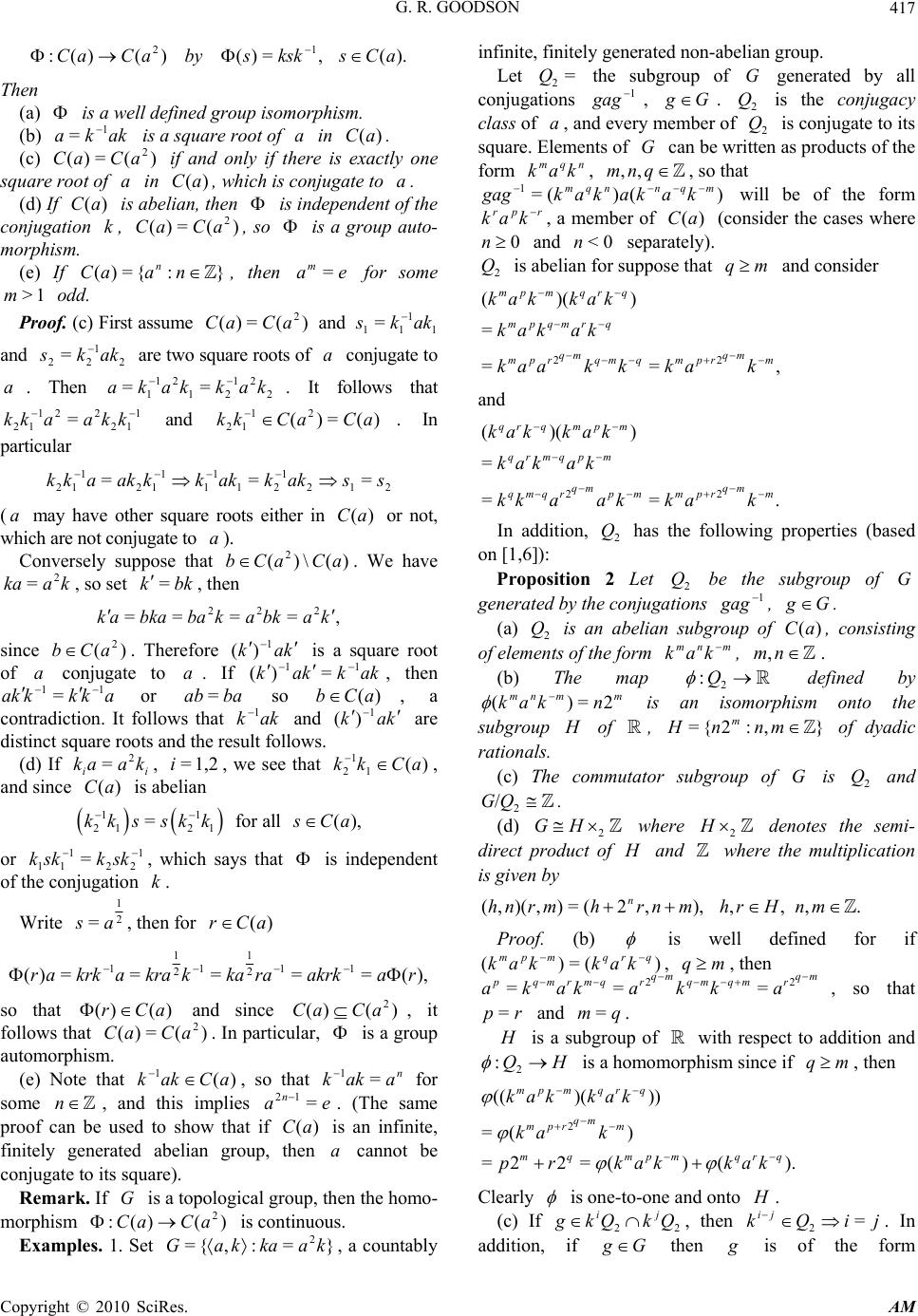 G. R. GOODSON Copyright © 2010 SciRes. AM 417 ).(,=)()()(: 12 aCsksksbyaCaC Then (a) is a well defined group isomorphism. (b) akka 1 = is a square root of a in )(aC . (c) )(=)(2 aCaC if and only if there is exactly one square root of a in )(aC, which is conjugate to a. (d) If )(aC is abelian, then is independent of the conjugation k, )(=)(2 aCaC , so is a group auto- morphism. (e) If }:{=)( naaC n, then eam= for some 1>m odd. Proof. (c) First assume )(=)(2 aCaC and 1 1 11 =akks and 2 1 22 =akks are two square roots of a conjugate to a. Then 2 21 21 21 1== kakkaka . It follows that 1 12 221 12 = kkaakk and )(=)(21 12 aCaCkk . In particular 212 1 21 1 1 1 12 1 12 === ssakkakkkakakk (a may have other square roots either in )(aC or not, which are not conjugate to a). Conversely suppose that )(\)( 2aCaCb. We have kaka2 =, so set bkk = , then ,==== 222kabkakbabkaak since )(2 aCb. Therefore kak 1 )( is a square root of a conjugate to a. If akkkak 11=)( , then akkkka 11 = or baab = so )(aCb, a contradiction. It follows that akk 1 and kak 1 )( are distinct square roots and the result follows. (d) If ii kaak 2 =, 1,2=i, we see that )( 1 1 2aCkk , and since )(aC is abelian 11 21 21 =forall(),kksskks Ca or 1 22 1 11 = skkskk , which says that is independent of the conjugation k. Write 2 1 =as , then for )(aCr ),(=====)( 11 2 1 1 2 1 1raakrkrakakkraakrkar so that )()(aCr and since )()( 2 aCaC , it follows that )(=)( 2 aCaC . In particular, is a group automorphism. (e) Note that )( 1aCakk , so that n aakk = 1 for some n, and this implies ean= 12 . (The same proof can be used to show that if )(aC is an infinite, finitely generated abelian group, then a cannot be conjugate to its square). Remark. If G is a topological group, then the homo- morphism )()(:2 aCaC is continuous. Examples. 1. Set }=:,{= 2kakakaG , a countably infinite, finitely generated non-abelian group. Let = 2 Q the subgroup of G generated by all conjugations 1 gag , Gg . 2 Q is the conjugacy class of a, and every member of 2 Q is conjugate to its square. Elements of G can be written as products of the form nqm kak , qnm ,,, so that )()(= 1mqnnqm kakakakgag will be of the form rpr kak , a member of )(aC (consider the cases where 0n and 0<n separately). 2 Q is abelian for suppose that mq and consider 22 ()() = ==, mp mqr q mpqmrq qm qm mprqmqmprm kak kak kak ak kaak kkak and 22 ()( ) = ==. qr qmpm qrmq pm qm qm qmqrpmmprm kakkak kak ak kkaakkak In addition, 2 Q has the following properties (based on [1,6]): Proposition 2 Let 2 Q be the subgroup of G generated by the conjugations 1 gag , Gg . (a) 2 Q is an abelian subgroup of )(aC, consisting of elements of the form mnm kak , nm,. (b) The map 2 :Q defined by mmnm nkak 2=)( is an isomorphism onto the subgroup H of , },:2{= mnnH m of dyadic rationals. (c) The commutator subgroup of G is 2 Q and 2 /QG. (d) 2 HG where 2 H denotes the semi- direct product of H and where the multiplication is given by .,,,),,2(=),)(,( mnHrhmnrhmrnhn Proof. (b) is well defined for if )(=)( qrqmpm kakkak , mq, then 22 == = qm qm pqmrmqr qmqmr akakakka , so that r p = and qm =. H is a subgroup of with respect to addition and HQ 2 : is a homomorphism since if mq , then 2 (()( )) =( ) =22=() (). mp mqr q qm mprm mq mpmqrq kak kak ka k pr kakkak Clearly is one-to-one and onto H . (c) If 22 QkQkg ji , then jiQkji = 2 . In addition, if Gg then g is of the form 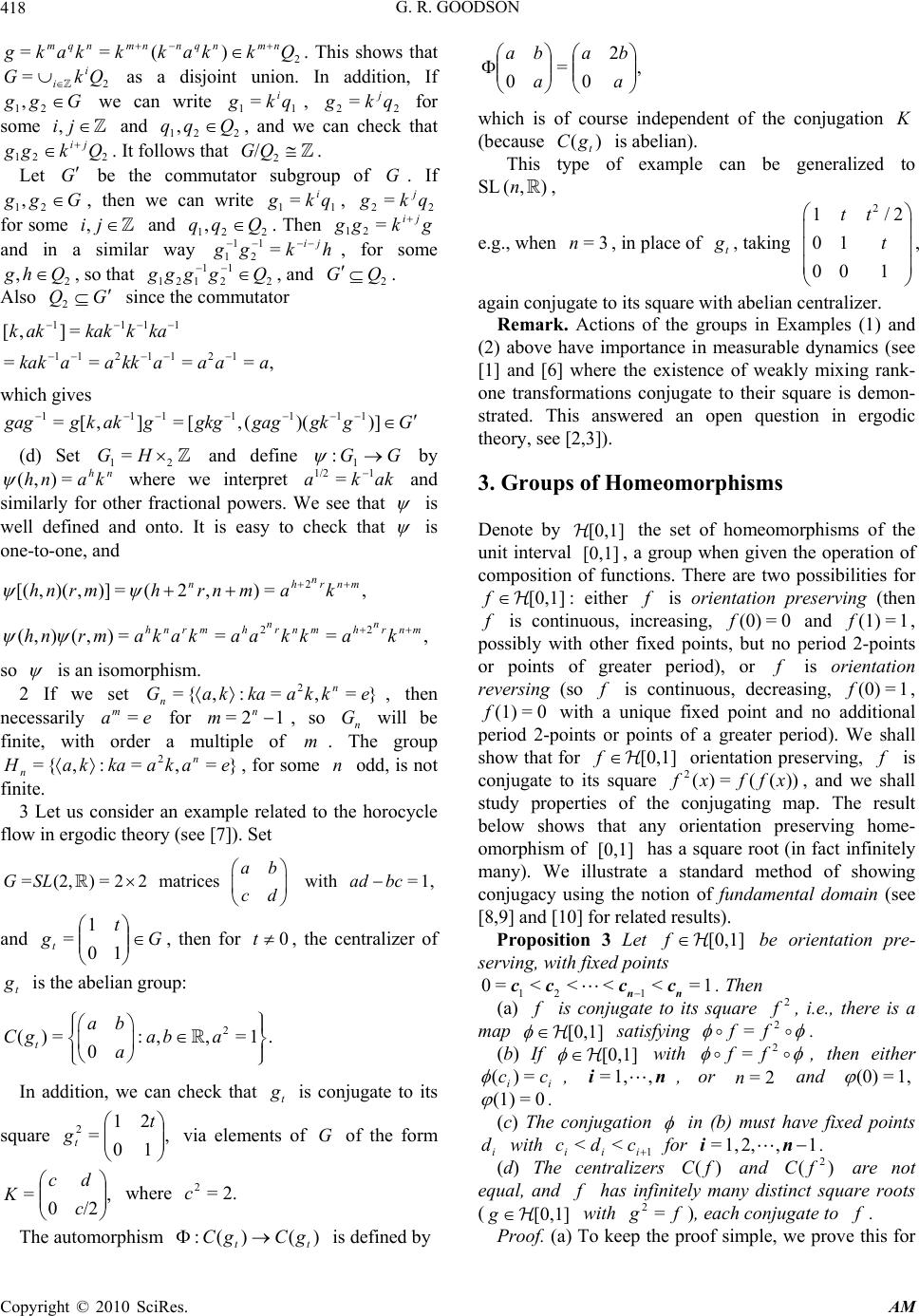 G. R. GOODSON Copyright © 2010 SciRes. AM 418 2 )(== Qkkakkkakg nmnqnnmnqm . This shows that 2 =QkG i i as a disjoint union. In addition, If Ggg 21 , we can write 11 =qkg i, 22 =qkgj for some ji , and 221,Qqq, and we can check that 221 Qkgg ji . It follows that 2 /QG. Let G be the commutator subgroup of G. If Ggg 21 ,, then we can write 11 =qkgi, 22 =qkgj for some ji, and 221,Qqq . Then gkgg ji = 21 and in a similar way hkgg ji = 1 2 1 1, for some 2 ,Qhg , so that 2 1 2 1 121 Qgggg , and 2 QG . Also GQ 2 since the commutator 1111 11 211 21 [, ]= == ==, kakkak k ka kaka akka aa a which gives 1111111 =[,] =[,()()] g aggk akggkggaggkgG (d) Set 21 =HG and define GG 1 : by nh kanh =),( where we interpret akka 11/2 = and similarly for other fractional powers. We see that is well defined and onto. It is easy to check that is one-to-one, and ,=),2(=)],)(,[( 2mnr n hn kamnrhmrnh ,===),(),( 22 mnr n hmnr n hmrnh kakkaakakamrnh so is an isomorphism. 2 If we set }=,=:,{= 2ekkakakaG n n , then necessarily eam= for 12= n m, so n G will be finite, with order a multiple of m. The group }=,=:,{= 2eakakakaH n n , for some n odd, is not finite. 3 Let us consider an example related to the horocycle flow in ergodic theory (see [7]). Set =(2,)=22matriceswith= 1, ab GSLadbc cd and G t gt 10 1 =, then for 0t, the centralizer of t g is the abelian group: 2 ()=:,, =1. 0 t ab Cgab a a In addition, we can check that t g is conjugate to its square , 10 21 = 2 t gt via elements of G of the form , /20 = c dc K where 2.= 2 c The automorphism )()(: tt gCgC is defined by , 0 2 = 0 a ba a ba which is of course independent of the conjugation K (because )( t gC is abelian). This type of example can be generalized to SL ),( n, e.g., when 3=n, in place of t g, taking 2 1/2 01 001 tt t , again conjugate to its square with abelian centralizer. Remark. Actions of the groups in Examples (1) and (2) above have importance in measurable dynamics (see [1] and [6] where the existence of weakly mixing rank- one transformations conjugate to their square is demon- strated. This answered an open question in ergodic theory, see [2,3]). 3. Groups of Homeomorphisms Denote by [0,1] the set of homeomorphisms of the unit interval [0,1] , a group when given the operation of composition of functions. There are two possibilities for [0,1] f: either f is orientation preserving (then f is continuous, increasing, 0=(0)f and 1=(1)f, possibly with other fixed points, but no period 2-points or points of greater period), or f is orientation reversing (so f is continuous, decreasing, 1=(0)f, 0=(1)f with a unique fixed point and no additional period 2-points or points of a greater period). We shall show that for [0,1] f orientation preserving, f is conjugate to its square ))((=)( 2xffxf , and we shall study properties of the conjugating map. The result below shows that any orientation preserving home- omorphism of [0,1] has a square root (in fact infinitely many). We illustrate a standard method of showing conjugacy using the notion of fundamental domain (see [8,9] and [10] for related results). Proposition 3 Let [0,1] f be orientation pre- serving, with fixed points 121 0= <<<<=1 nn cccc . Then (a) f is conjugate to its square 2 f, i.e., there is a map [0,1] satisfying 2 =ff . (b) If [0,1] with 2 =ff , then either ii cc =)( , =1,,in, or 2=n and (0)= 1, (1) = 0 . (c) The conjugation in (b) must have fixed points i d with 1 <<iiicdc for =1,2, ,1 in. (d) The centralizers )( fC and )(2 fC are not equal, and f has infinitely many distinct square roots ([0,1] g with fg = 2), each conjugate to f. Proof. (a) To keep the proof simple, we prove this for 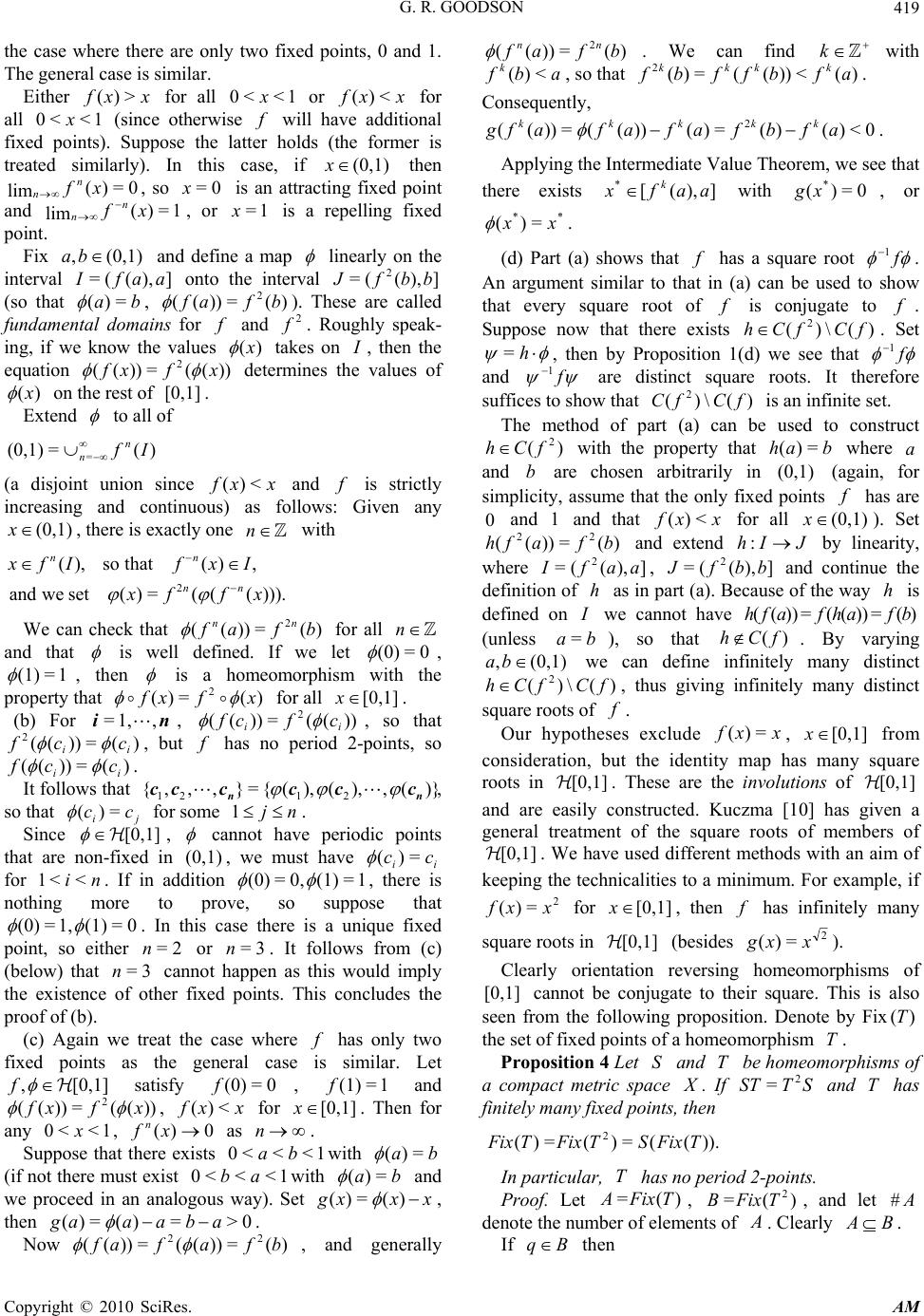 G. R. GOODSON Copyright © 2010 SciRes. AM 419 the case where there are only two fixed points, 0 and 1. The general case is similar. Either xxf>)( for all 1<<0 x or xxf <)( for all 1<<0 x (since otherwise f will have additional fixed points). Suppose the latter holds (the former is treated similarly). In this case, if (0,1)x then 0=)( lim xf n n , so 0=x is an attracting fixed point and 1=)( lim xf n n , or 1=x is a repelling fixed point. Fix (0,1), ba and define a map linearly on the interval ]),((= aafI onto the interval ]),((= 2bbfJ (so that ba =)( , )(=))(( 2bfaf ). These are called fundamental domains for f and 2 f. Roughly speak- ing, if we know the values )(x takes on I , then the equation ))((=))(( 2xfxf determines the values of )(x on the rest of [0,1]. Extend to all of )(=(0,1) =Ifn n (a disjoint union since xxf <)( and f is strictly increasing and continuous) as follows: Given any (0,1)x, there is exactly one n with 2 (), sothat(), andweset( )=((( ))). nn nn xfIfxI x ffx We can check that )(=))(( 2bfaf nn for all n and that is well defined. If we let 0=(0) , 1=(1) , then is a homeomorphism with the property that )(=)( 2xfxf for all [0,1]x. (b) For =1,, in, ))((=))(( 2 iicfcf , so that )(=))(( 2 ii ccf , but f has no period 2-points, so )(=))(( ii ccf . It follows that 1212 {,,, }={(),( ),,() } nn cccccc , so that ji cc =)( for some nj 1. Since [0,1] , cannot have periodic points that are non-fixed in (0,1) , we must have ii cc =)( for ni<<1 . If in addition 1=(1)0,=(0) , there is nothing more to prove, so suppose that 0=(1)1,=(0) . In this case there is a unique fixed point, so either 2=n or 3=n. It follows from (c) (below) that 3=n cannot happen as this would imply the existence of other fixed points. This concludes the proof of (b). (c) Again we treat the case where f has only two fixed points as the general case is similar. Let [0,1], f satisfy 0=(0)f, 1=(1)f and ))((=))(( 2xfxf , xxf<)( for [0,1]x. Then for any 1<<0 x, 0)( xfn as n. Suppose that there exists 1<<<0 ba with ba=)( (if not there must exist 1<<<0ab with ba =)( and we proceed in an analogous way). Set xxxg )(=)( , then 0>=)(=)( abaaag . Now )(=))((=))(( 22 bfafaf , and generally )(=))((2bfaf nn . We can find kwith abf k<)(, so that )(<))((=)( 2afbffbf kkkk. Consequently, 0<)()(=)())((=))(( 2afbfafafafg kkkkk . Applying the Intermediate Value Theorem, we see that there exists ]),([ *aafx k with 0=)( * xg , or ** =)( xx . (d) Part (a) shows that f has a square root f 1. An argument similar to that in (a) can be used to show that every square root of f is conjugate to f. Suppose now that there exists )(\)(2fCfCh. Set h=, then by Proposition 1(d) we see that f 1 and f 1 are distinct square roots. It therefore suffices to show that )(\)( 2fCfC is an infinite set. The method of part (a) can be used to construct )( 2 fCh with the property that bah =)( where a and b are chosen arbitrarily in (0,1) (again, for simplicity, assume that the only fixed points f has are 0 and 1 and that xxf <)( for all (0,1)x). Set )(=))(( 22bfafh and extend JIh : by linearity, where ]),((= 2aafI, ]),((= 2bbfJ and continue the definition of h as in part (a). Because of the way h is defined on I we cannot have )(=))((=))(( bfahfafh (unless ba=), so that )( fCh. By varying (0,1), ba we can define infinitely many distinct )(\)( 2fCfCh , thus giving infinitely many distinct square roots of f. Our hypotheses exclude xxf=)( , [0,1]x from consideration, but the identity map has many square roots in [0,1]. These are the involutions of [0,1] and are easily constructed. Kuczma [10] has given a general treatment of the square roots of members of [0,1]. We have used different methods with an aim of keeping the technicalities to a minimum. For example, if 2 =)( xxf for [0,1] x, then f has infinitely many square roots in [0,1] (besides 2 =)( xxg ). Clearly orientation reversing homeomorphisms of [0,1] cannot be conjugate to their square. This is also seen from the following proposition. Denote by Fix)(T the set of fixed points of a homeomorphism T . Proposition 4 Let S and T be homeomorphisms of a compact metric space X . If STST2 = and T has finitely many fixed points, then )).((=)(=)( 2TFixSTFixTFix In particular, T has no period 2-points. Proof. Let )(= TFixA , )(=2 TFixB , and let A # denote the number of elements of A . Clearly BA . If Bq then 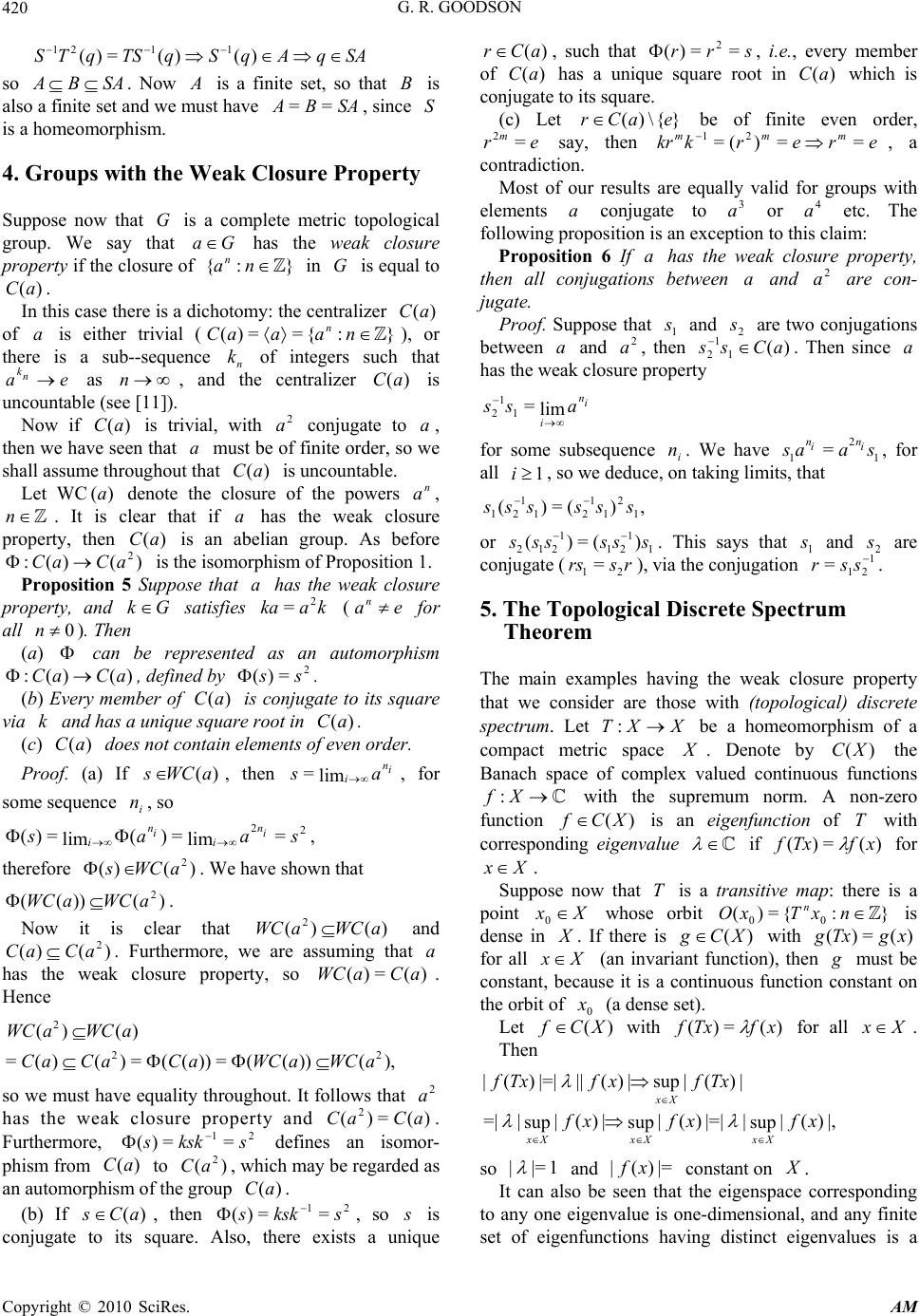 G. R. GOODSON Copyright © 2010 SciRes. AM 420 121 1 ()= ()()STq TSqSqAqSA so SABA . Now A is a finite set, so that B is also a finite set and we must have SABA== , since S is a homeomorphism. 4. Groups with the Weak Closure Property Suppose now that G is a complete metric topological group. We say that Ga has the weak closure property if the closure of }:{ nan in G is equal to )(aC . In this case there is a dichotomy: the centralizer )(aC of a is either trivial (}:{==)( naaaC n), or there is a sub--sequence n k of integers such that ean k as n, and the centralizer )(aC is uncountable (see [11]). Now if )(aC is trivial, with 2 a conjugate to a, then we have seen that a must be of finite order, so we shall assume throughout that )(aC is uncountable. Let WC)(a denote the closure of the powers n a, n. It is clear that if a has the weak closure property, then )(aC is an abelian group. As before )()(: 2 aCaC is the isomorphism of Proposition 1. Proposition 5 Suppose that a has the weak closure property, and Gk satisfies kaka2 = (ean for all 0n). Then (a) can be represented as an automorphism )()(: aCaC , defined by 2 =)( ss. (b) Every member of )(aC is conjugate to its square via k and has a unique square root in )(aC . (c) )(aC does not contain elements of even order. Proof. (a) If )(aWCs , then i n iaslim = , for some sequence i n, so 2 2= lim =)( lim =)( saas i n i i n i , therefore )()( 2 aWCs . We have shown that )())(( 2 aWCaWC . Now it is clear that )()(2aWCaWC and )()( 2 aCaC . Furthermore, we are assuming that a has the weak closure property, so )(=)( aCaWC . Hence 2 22 () () =()() =(())=(())(), WC aWC a Ca CaCaWCaWCa so we must have equality throughout. It follows that 2 a has the weak closure property and )(=)( 2aCaC . Furthermore, 21 ==)( sksks defines an isomor- phism from )(aC to )( 2 aC , which may be regarded as an automorphism of the group )(aC . (b) If )(aCs , then 21==)(sksks , so s is conjugate to its square. Also, there exists a unique )(aCr , such that srr ==)( 2 , i.e., every member of )(aC has a unique square root in )(aC which is conjugate to its square. (c) Let }{\)(eaCr be of finite even order, er m= 2 say, then ererkkrmmm ==)(= 21 , a contradiction. Most of our results are equally valid for groups with elements a conjugate to 3 a or 4 a etc. The following proposition is an exception to this claim: Proposition 6 If a has the weak closure property, then all conjugations between a and 2 a are con- jugate. Proof. Suppose that 1 s and 2 s are two conjugations between a and 2 a, then )( 1 1 2aCss . Then since a has the weak closure property i n i ass lim = 1 1 2 for some subsequence i n. We have 2 11 = nn ii s aas , for all 1i, so we deduce, on taking limits, that ,)(=)( 1 2 1 1 21 1 21 ssssss or 11 21212 1 ()=() s ssss s . This says that 1 s and 2 s are conjugate (12 =rssr ), via the conjugation 1 21 = ssr . 5. The Topological Discrete Spectrum Theorem The main examples having the weak closure property that we consider are those with (topological) discrete spectrum. Let XXT: be a homeomorphism of a compact metric space X . Denote by )(XC the Banach space of complex valued continuous functions Xf: with the supremum norm. A non-zero function )(XCf is an eigenfunction of T with corresponding eigenvalue if )(=)( xfTxf for Xx . Suppose now that T is a transitive map: there is a point Xx 0 whose orbit }:{=)(00 nxTxO n is dense in X . If there is )(XCg with )(=)( xgTxg for all Xx (an invariant function), then g must be constant, because it is a continuous function constant on the orbit of 0 x (a dense set). Let )(XCf with )(=)( xfTxf for all Xx . Then |()|=|||()| |()| sup =|||()|| ()|=||| ()|, sup supsup xX xX xXxX fTxf xfTx f xfx fx so 1|=| and |=)(| xf constant on X . It can also be seen that the eigenspace corresponding to any one eigenvalue is one-dimensional, and any finite set of eigenfunctions having distinct eigenvalues is a 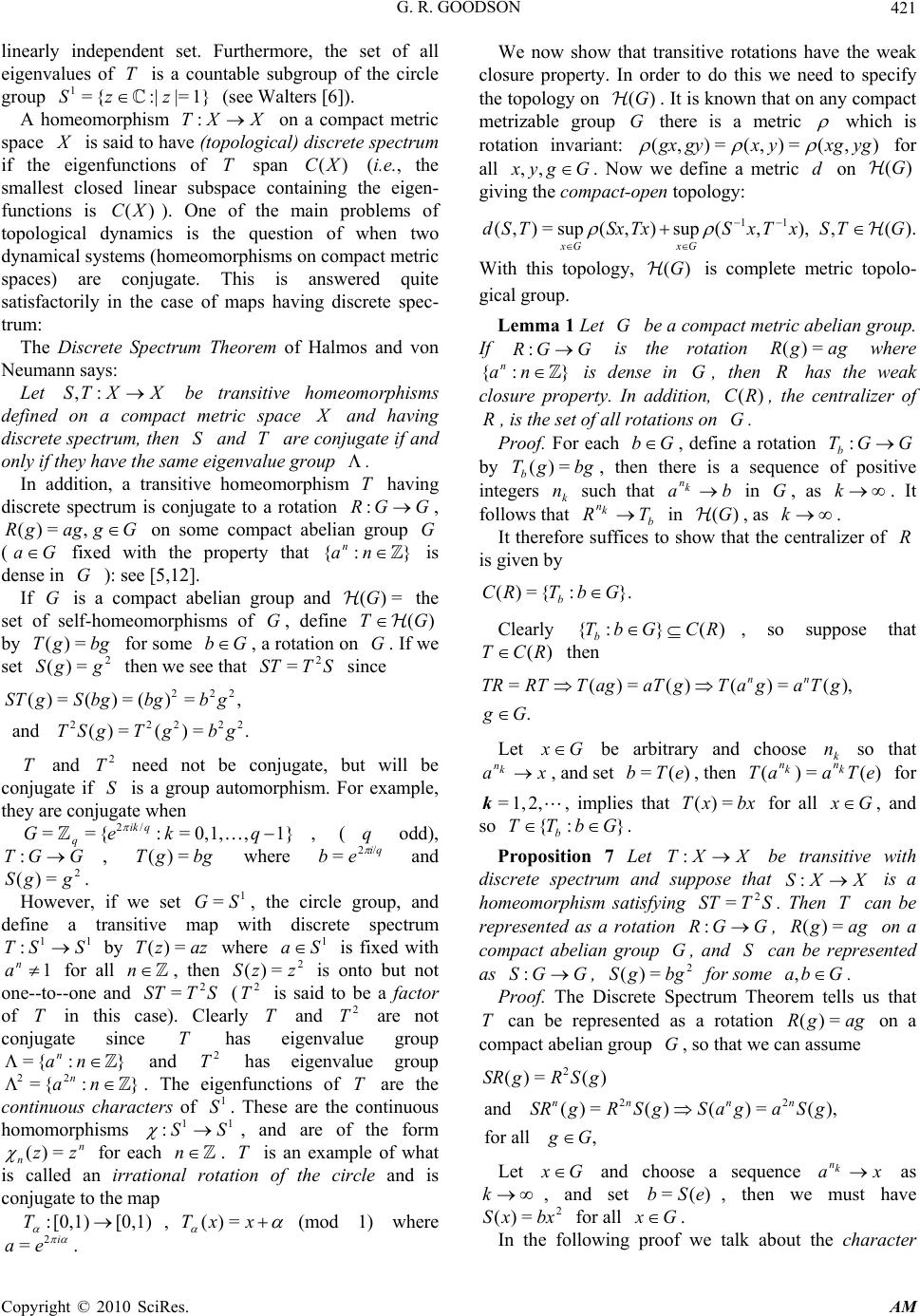 G. R. GOODSON Copyright © 2010 SciRes. AM 421 linearly independent set. Furthermore, the set of all eigenvalues of T is a countable subgroup of the circle group 1}|=:|{= 1zzS (see Walters [6]). A homeomorphism XXT : on a compact metric space X is said to have (topological) discrete spectrum if the eigenfunctions of T span )(XC (i.e., the smallest closed linear subspace containing the eigen- functions is )(XC ). One of the main problems of topological dynamics is the question of when two dynamical systems (homeomorphisms on compact metric spaces) are conjugate. This is answered quite satisfactorily in the case of maps having discrete spec- trum: The Discrete Spectrum Theorem of Halmos and von Neumann says: Let XXTS :, be transitive homeomorphisms defined on a compact metric space X and having discrete spectrum, then S and T are conjugate if and only if they have the same eigenvalue group . In addition, a transitive homeomorphism T having discrete spectrum is conjugate to a rotation GGR:, GgaggR,=)( on some compact abelian group G (Ga fixed with the property that }:{ nan is dense in G ): see [5,12]. If G is a compact abelian group and =)(G the set of self-homeomorphisms of G, define )(GT by bggT =)( for some Gb , a rotation on G. If we set 2 =)( ggS then we see that STST2 = since 222 22222 ()= ()=()=, and() =()=. STgS bgbgbg TSgTgbg T and 2 T need not be conjugate, but will be conjugate if S is a group automorphism. For example, they are conjugate when 2/ =={ :=0,1,,1} ik q q Gek q , (q odd), GGT :, bggT =)( where qi eb /2 = and 2 =)(ggS . However, if we set 1 =SG, the circle group, and define a transitive map with discrete spectrum 11 :SST by azzT =)( where 1 Sa is fixed with 1 n a for all n, then 2 =)( zzS is onto but not one--to--one and STST2 = ( 2 T is said to be a factor of T in this case). Clearly T and 2 T are not conjugate since T has eigenvalue group }:{= nan and 2 T has eigenvalue group }:{= 22 na n. The eigenfunctions of T are the continuous characters of 1 S. These are the continuous homomorphisms 11 :SS , and are of the form n nzz =)( for each n. T is an example of what is called an irrational rotation of the circle and is conjugate to the map [0,1)[0,1): T, xxT =)( (mod 1) where 2 =i ae . We now show that transitive rotations have the weak closure property. In order to do this we need to specify the topology on )(G . It is known that on any compact metrizable group G there is a metric which is rotation invariant: ),(=),(=),( ygxgyxgygx for all Ggyx ,, . Now we define a metric d on )(G giving the compact- open topology: ).(,),,( sup ),( sup =),( 11 GTSxTxSTxSxTSd GxGx With this topology, )(G is complete metric topolo- gical group. Lemma 1 Let G be a compact metric abelian group. If GGR: is the rotation aggR =)( where }:{ nan is dense in G, then R has the weak closure property. In addition, )(RC, the centralizer of R, is the set of all rotations on G. Proof. For each Gb , define a rotation GGTb: by bggTb=)( , then there is a sequence of positive integers k n such that ba k n in G, as k. It follows that b k nTR in )(G , as k. It therefore suffices to show that the centralizer of R is given by }.:{=)( GbTRCb Clearly )(}:{ RCGbTb , so suppose that )(RCT then =()=()()=(), . nn TRRT Tag aTgTagaTg gG Let Gx be arbitrary and choose k n so that xak n, and set )(= eTb, then )(=)(eTaaTk n k n for =1,2,k, implies that bxxT =)( for all Gx , and so }:{ GbTT b . Proposition 7 Let :TX X be transitive with discrete spectrum and suppose that XXS : is a homeomorphism satisfying STST2 =. Then T can be represented as a rotation GGR :, aggR =)( on a compact abelian group G, and S can be represented as GGS :, 2 =)( bggS for some Gba ,. Proof. The Discrete Spectrum Theorem tells us that T can be represented as a rotation aggR =)( on a compact abelian group G, so that we can assume 2 22 ()= () and( )=( )()=( ), for all, nn nn SR gR Sg SRgR SgSaga Sg gG Let Gx and choose a sequence xa k n as k, and set )(= eSb , then we must have 2 =)( bxxS for all Gx . In the following proof we talk about the character 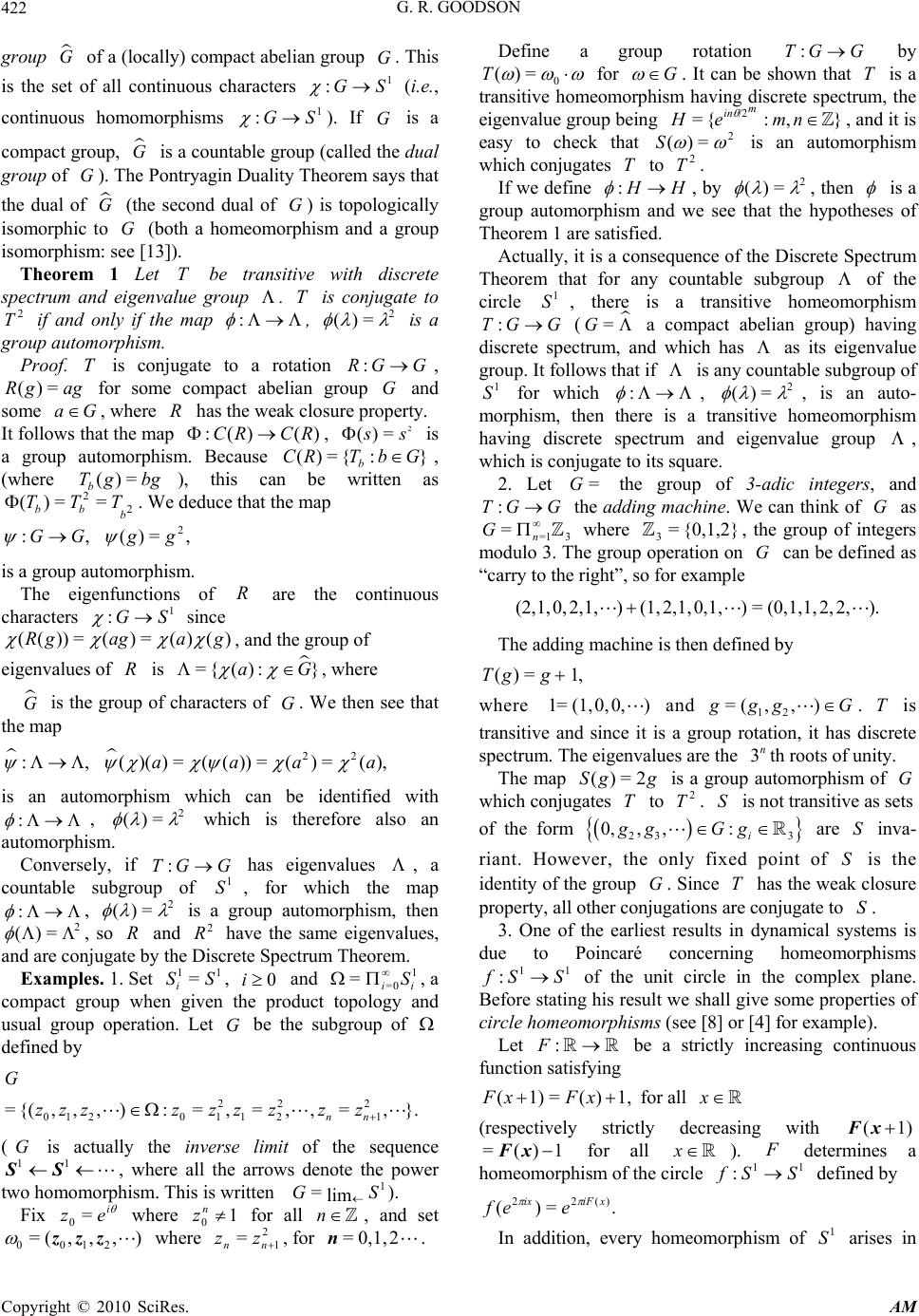 G. R. GOODSON Copyright © 2010 SciRes. AM 422 group G of a (locally) compact abelian group G. This is the set of all continuous characters 1 :SG (i.e., continuous homomorphisms 1 :SG ). If G is a compact group, G is a countable group (called the dual group of G). The Pontryagin Duality Theorem says that the dual of G (the second dual of G) is topologically isomorphic to G (both a homeomorphism and a group isomorphism: see [13]). Theorem 1 Let T be transitive with discrete spectrum and eigenvalue group . T is conjugate to 2 T if and only if the map : , 2 =)( is a group automorphism. Proof. T is conjugate to a rotation GGR:, aggR=)( for some compact abelian group G and some Ga , where R has the weak closure property. It follows that the map )()(: RCRC , 2 ()= s s is a group automorphism. Because }:{=)( GbTRCb , (where bggTb=)( ), this can be written as 2 2==)( b bb TTT. We deduce that the map ,=)(,: 2 ggGG is a group automorphism. The eigenfunctions of R are the continuous characters 1 :SG since )()(=)(=))(( gaaggR , and the group of eigenvalues of R is ={( ):}aG , where G is the group of characters of G. We then see that the map 22 :,()()=(())=( )=(),aaaa is an automorphism which can be identified with : , 2 =)( which is therefore also an automorphism. Conversely, if GGT : has eigenvalues , a countable subgroup of 1 S, for which the map : , 2 =)( is a group automorphism, then 2 =)( , so R and 2 R have the same eigenvalues, and are conjugate by the Discrete Spectrum Theorem. Examples. 1. Set 11=SSi, 0i and 1 0= =ii S , a compact group when given the product topology and usual group operation. Let G be the subgroup of defined by 22 2 01201121 ={( , ,,):=,=,,=,}. nn G zzzzzz zzz (G is actually the inverse limit of the sequence 11 SS , where all the arrows denote the power two homomorphism. This is written 1 lim =SG ). Fix i ez= 0 where 1 0 n z for all n, and set 0012 =( , ,,) zzz where 2 1 =nnzz , for = 0,1,2n. Define a group rotation GGT : by 0 =)(T for G . It can be shown that T is a transitive homeomorphism having discrete spectrum, the eigenvalue group being },:{= /2 nmeHm in , and it is easy to check that 2 =)( S is an automorphism which conjugates T to 2 T. If we define HH : , by 2 =)( , then is a group automorphism and we see that the hypotheses of Theorem 1 are satisfied. Actually, it is a consequence of the Discrete Spectrum Theorem that for any countable subgroup of the circle 1 S, there is a transitive homeomorphism GGT : ( =G a compact abelian group) having discrete spectrum, and which has as its eigenvalue group. It follows that if is any countable subgroup of 1 S for which : , 2 =)( , is an auto- morphism, then there is a transitive homeomorphism having discrete spectrum and eigenvalue group , which is conjugate to its square. 2. Let =G the group of 3-adic integers, and GGT : the adding machine. We can think of G as 31= = n G where {0,1,2}= 3 , the group of integers modulo 3. The group operation on G can be defined as “carry to the right”, so for example (2,1, 0, 2,1,)(1, 2,1, 0,1,)=(0,1,1, 2, 2,). The adding machine is then defined by ,1=)( ggT where 1= (1,0,0,) and 12 =( ,,) g gg G. T is transitive and since it is a group rotation, it has discrete spectrum. The eigenvalues are the n 3th roots of unity. The map ggS 2=)( is a group automorphism of G which conjugates T to 2 T. S is not transitive as sets of the form 23 3 0,,,: i gg Gg are S inva- riant. However, the only fixed point of S is the identity of the group G. Since T has the weak closure property, all other conjugations are conjugate to S. 3. One of the earliest results in dynamical systems is due to Poincaré concerning homeomorphisms 11 :SSf of the unit circle in the complex plane. Before stating his result we shall give some properties of circle homeomorphisms (see [8] or [4] for example). Let :F be a strictly increasing continuous function satisfying (1)=()1,Fx Fx for all x (respectively strictly decreasing with (1) Fx =()1 Fx for all x). F determines a homeomorphism of the circle 11 :SSf defined by .=)( )(22 xiFixeef In addition, every homeomorphism of 1 S arises in 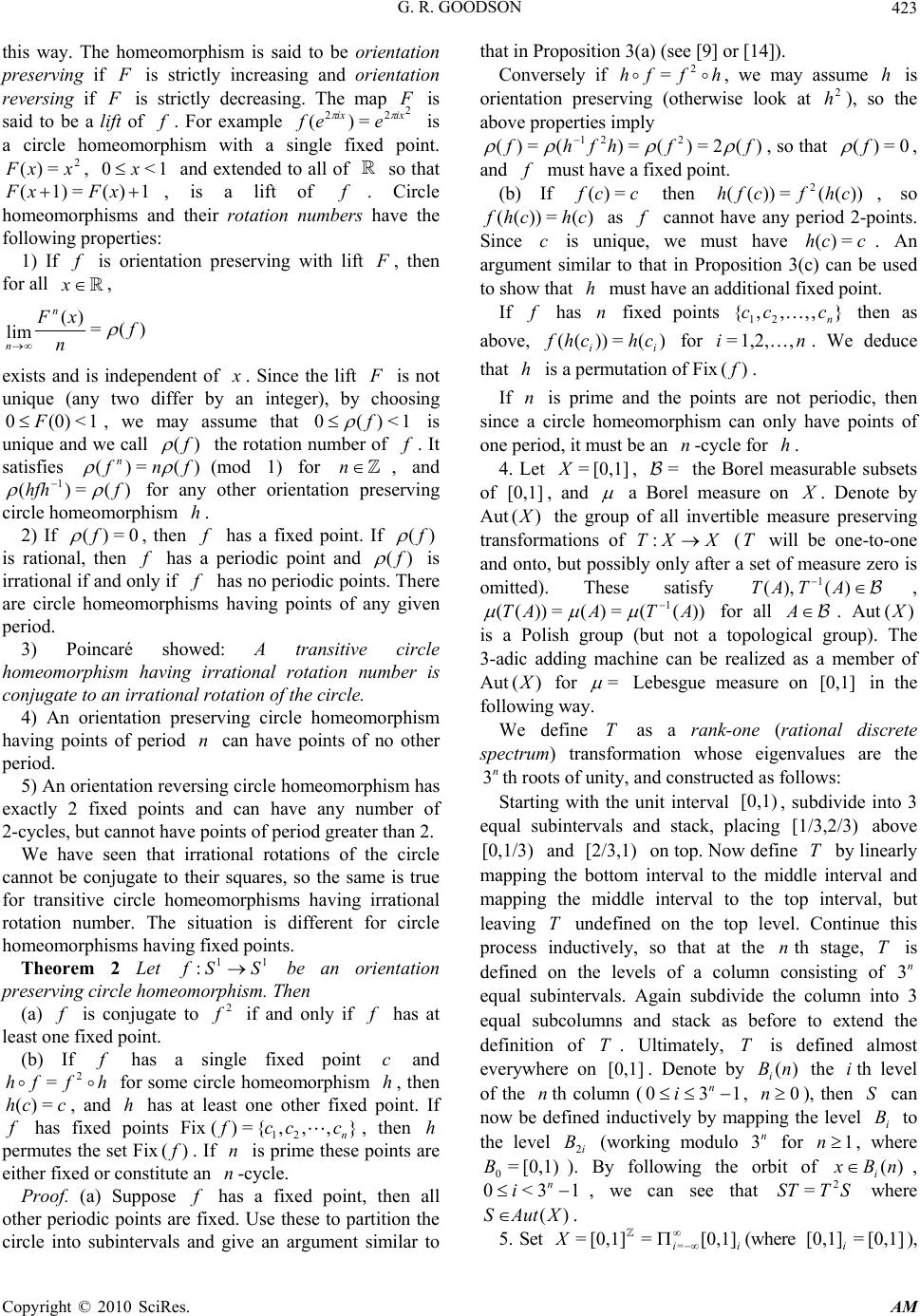 G. R. GOODSON Copyright © 2010 SciRes. AM 423 this way. The homeomorphism is said to be orientation preserving if F is strictly increasing and orientation reversing if F is strictly decreasing. The map F is said to be a lift of f. For example 2 22=)( ixix eef is a circle homeomorphism with a single fixed point. 2 =)( xxF , 1<0 x and extended to all of so that 1)(=1)( xFxF , is a lift of f. Circle homeomorphisms and their rotation numbers have the following properties: 1) If f is orientation preserving with lift F , then for all x, )(= )( lim f n xF n n exists and is independent of x . Since the lift F is not unique (any two differ by an integer), by choosing 1<(0)0 F, we may assume that 1<)(0f is unique and we call )( f the rotation number of f. It satisfies )(=)(fnf n (mod 1) for n, and )(=)( 1fhfh for any other orientation preserving circle homeomorphism h. 2) If 0=)( f , then f has a fixed point. If )( f is rational, then f has a periodic point and )( f is irrational if and only if f has no periodic points. There are circle homeomorphisms having points of any given period. 3) Poincaré showed: A transitive circle homeomorphism having irrational rotation number is conjugate to an irrational rotation of the circle. 4) An orientation preserving circle homeomorphism having points of period n can have points of no other period. 5) An orientation reversing circle homeomorphism has exactly 2 fixed points and can have any number of 2-cycles, but cannot have points of period greater than 2. We have seen that irrational rotations of the circle cannot be conjugate to their squares, so the same is true for transitive circle homeomorphisms having irrational rotation number. The situation is different for circle homeomorphisms having fixed points. Theorem 2 Let 11 :SSf be an orientation preserving circle homeomorphism. Then (a) f is conjugate to 2 f if and only if f has at least one fixed point. (b) If f has a single fixed point c and hffh 2 = for some circle homeomorphism h, then cch =)( , and h has at least one other fixed point. If f has fixed points Fix12 ()={, ,, } n f cc c, then h permutes the set Fix)( f. If n is prime these points are either fixed or constitute an n-cycle. Proof. (a) Suppose f has a fixed point, then all other periodic points are fixed. Use these to partition the circle into subintervals and give an argument similar to that in Proposition 3(a) (see [9] or [14]). Conversely if hffh 2 =, we may assume h is orientation preserving (otherwise look at 2 h), so the above properties imply )(2=)(=)(=)( 221 ffhfhf , so that 0=)( f , and f must have a fixed point. (b) If ccf =)( then ))((=))(( 2chfcfh , so )(=))(( chchf as f cannot have any period 2-points. Since c is unique, we must have cch=)( . An argument similar to that in Proposition 3(c) can be used to show that h must have an additional fixed point. If f has n fixed points },,,,{ 21 n ccc then as above, )(=))(( ii chchf for ni ,1,2,=. We deduce that h is a permutation of Fix)( f. If n is prime and the points are not periodic, then since a circle homeomorphism can only have points of one period, it must be an n-cycle for h. 4. Let [0,1]=X, = the Borel measurable subsets of [0,1] , and a Borel measure on X . Denote by Aut )(X the group of all invertible measure preserving transformations of XXT: ( T will be one-to-one and onto, but possibly only after a set of measure zero is omitted). These satisfy 1 (),()TATA , ))((=)(=))((1ATAAT for all A. Aut)(X is a Polish group (but not a topological group). The 3-adic adding machine can be realized as a member of Aut )(X for = Lebesgue measure on [0,1] in the following way. We define T as a rank-one (rational discrete spectrum) transformation whose eigenvalues are the n 3th roots of unity, and constructed as follows: Starting with the unit interval [0,1) , subdivide into 3 equal subintervals and stack, placing [1/3,2/3) above [0,1/3) and [2/3,1) on top. Now define T by linearly mapping the bottom interval to the middle interval and mapping the middle interval to the top interval, but leaving T undefined on the top level. Continue this process inductively, so that at the nth stage, T is defined on the levels of a column consisting of n 3 equal subintervals. Again subdivide the column into 3 equal subcolumns and stack as before to extend the definition of T . Ultimately, T is defined almost everywhere on [0,1] . Denote by )(nBi the ith level of the nth column (130 n i, 0n), then S can now be defined inductively by mapping the level i B to the level i B2 (working modulo n 3 for 1n, where [0,1)= 0 B). By following the orbit of )(nBxi , 13<0 n i, we can see that STST2 = where )(XAutS . 5. Set ii X[0,1]=[0,1]= = (where [0,1]=[0,1]i), 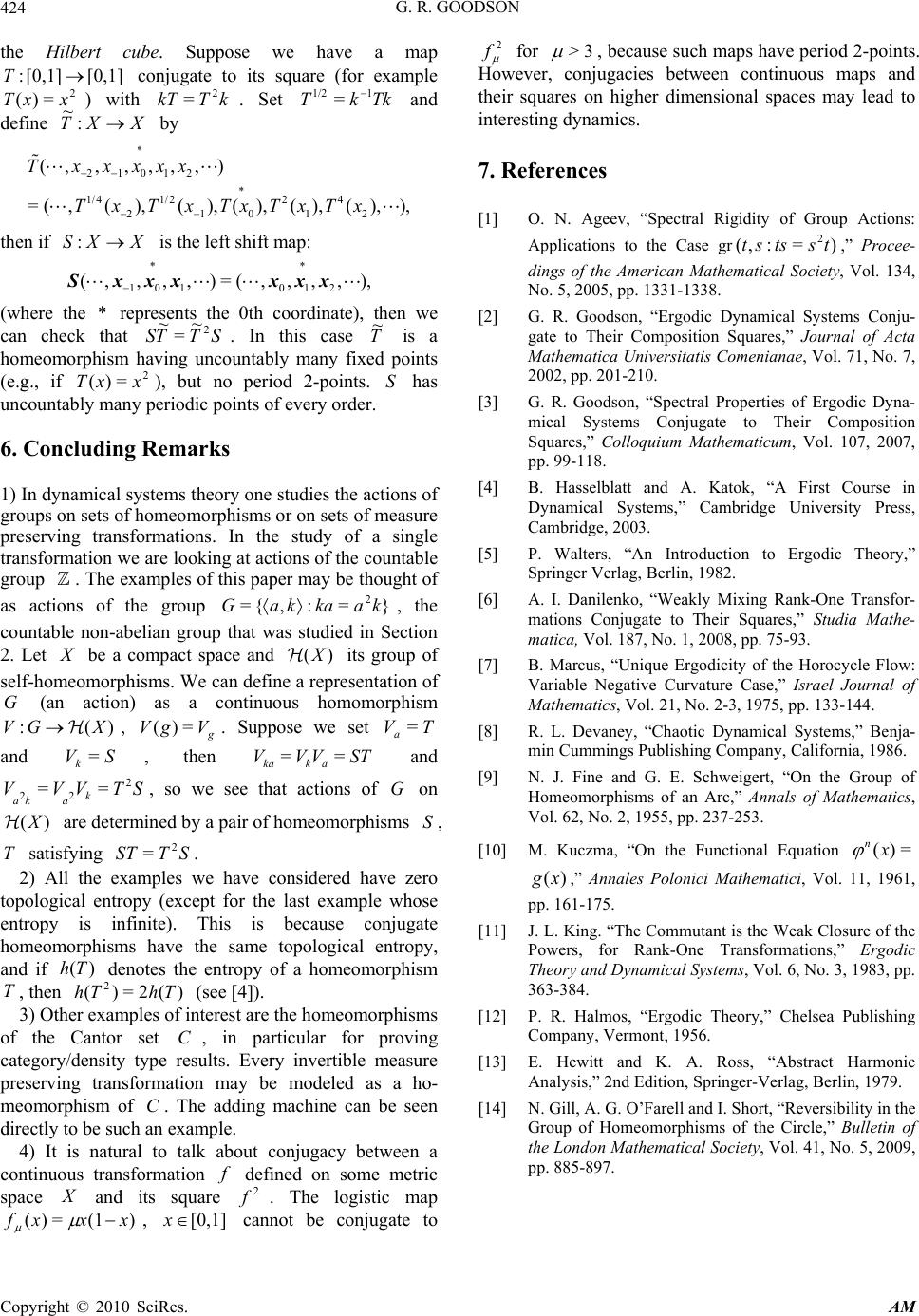 G. R. GOODSON Copyright © 2010 SciRes. AM 424 the Hilbert cube. Suppose we have a map [0,1][0,1]:T conjugate to its square (for example 2 =)( xxT ) with kTkT 2 =. Set TkkT 11/2 = and define XXT: ~ by * 21012 * 1/41/22 4 21012 (,,,,,,) =(,(),(),(), (), (),), Txxxxx TxTxTxTxTx then if XXS: is the left shift map: ** 101012 (,, ,,)=(,,,,), Sx xxxxx (where the * represents the 0th coordinate), then we can check that STTS 2 ~ = ~ . In this case T ~ is a homeomorphism having uncountably many fixed points (e.g., if 2 =)( xxT), but no period 2-points. S has uncountably many periodic points of every order. 6. Concluding Remarks 1) In dynamical systems theory one studies the actions of groups on sets of homeomorphisms or on sets of measure preserving transformations. In the study of a single transformation we are looking at actions of the countable group . The examples of this paper may be thought of as actions of the group }=:,{= 2kakakaG , the countable non-abelian group that was studied in Section 2. Let X be a compact space and )(X its group of self-homeomorphisms. We can define a representation of G (an action) as a continuous homomorphism )(:XGV , g VgV =)( . Suppose we set TVa= and SVk=, then STVVV akka== and STVVV k aka 2 22== , so we see that actions of G on )(X are determined by a pair of homeomorphisms S, T satisfying STST2 =. 2) All the examples we have considered have zero topological entropy (except for the last example whose entropy is infinite). This is because conjugate homeomorphisms have the same topological entropy, and if )(Th denotes the entropy of a homeomorphism T , then )(2=)( 2ThTh (see [4]). 3) Other examples of interest are the homeomorphisms of the Cantor set C, in particular for proving category/density type results. Every invertible measure preserving transformation may be modeled as a ho- meomorphism of C. The adding machine can be seen directly to be such an example. 4) It is natural to talk about conjugacy between a continuous transformation f defined on some metric space X and its square 2 f. The logistic map )(1=)( xxxf , [0,1]x cannot be conjugate to 2 f for 3> , because such maps have period 2-points. However, conjugacies between continuous maps and their squares on higher dimensional spaces may lead to interesting dynamics. 7. References [1] O. N. Ageev, “Spectral Rigidity of Group Actions: Applications to the Case gr)=:,(2tstsst ,” Procee- dings of the American Mathematical Society, Vol. 134, No. 5, 2005, pp. 1331-1338. [2] G. R. Goodson, “Ergodic Dynamical Systems Conju- gate to Their Composition Squares,” Journal of Acta Mathematica Universitatis Comenianae, Vol. 71, No. 7, 2002, pp. 201-210. [3] G. R. Goodson, “Spectral Properties of Ergodic Dyna- mical Systems Conjugate to Their Composition Squares,” Colloquium Mathematicum, Vol. 107, 2007, pp. 99-118. [4] B. Hasselblatt and A. Katok, “A First Course in Dynamical Systems,” Cambridge University Press, Cambridge, 2003. [5] P. Walters, “An Introduction to Ergodic Theory,” Springer Verlag, Berlin, 1982. [6] A. I. Danilenko, “Weakly Mixing Rank-One Transfor- mations Conjugate to Their Squares,” Studia Mathe- matica, Vol. 187, No. 1, 2008, pp. 75-93. [7] B. Marcus, “Unique Ergodicity of the Horocycle Flow: Variable Negative Curvature Case,” Israel Journal of Mathematics, Vol. 21, No. 2-3, 1975, pp. 133-144. [8] R. L. Devaney, “Chaotic Dynamical Systems,” Benja- min Cummings Publishing Company, California, 1986. [9] N. J. Fine and G. E. Schweigert, “On the Group of Homeomorphisms of an Arc,” Annals of Mathematics, Vol. 62, No. 2, 1955, pp. 237-253. [10] M. Kuczma, “On the Functional Equation ()= n x () g x,” Annales Polonici Mathematici, Vol. 11, 1961, pp. 161-175. [11] J. L. King. “The Commutant is the Weak Closure of the Powers, for Rank-One Transformations,” Ergodic Theory and Dynamical Systems, Vol. 6, No. 3, 1983, pp. 363-384. [12] P. R. Halmos, “Ergodic Theory,” Chelsea Publishing Company, Vermont, 1956. [13] E. Hewitt and K. A. Ross, “Abstract Harmonic Analysis,” 2nd Edition, Springer-Verlag, Berlin, 1979. [14] N. Gill, A. G. O’Farell and I. Short, “Reversibility in the Group of Homeomorphisms of the Circle,” Bulletin of the London Mathematical Society, Vol. 41, No. 5, 2009, pp. 885-897. |

